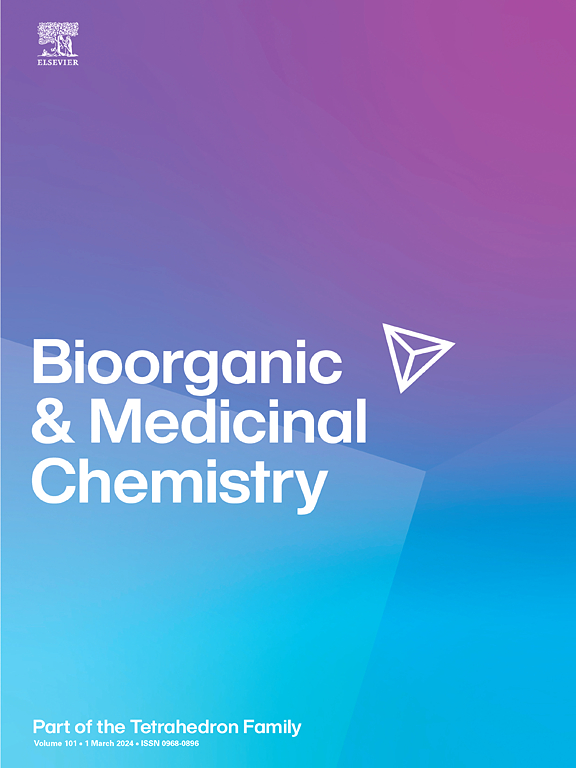Synthesis and biological evaluation of Sulforaphane derivatives with dual functions: Ischemia-reperfusion injury protection and antitumor effects
IF 3
3区 医学
Q2 BIOCHEMISTRY & MOLECULAR BIOLOGY
引用次数: 0
Abstract
Reperfusion therapy for the treatment of acute myocardial infarction (AMI) often leads to ischemia-reperfusion (I/R) injuries, characterized by excessive ROS. Sulforaphane (SFN) homologous, known for their anti-inflammatory and antioxidant properties, activate the nuclear factor-erythroid 2-related factor 2 (Nrf2) pathway and reduce mitochondrial ROS but are limited by poor stability and short half-life. SFN derivatives were synthesized through structural modifications of the dithiocarbamate and thiourea moieties at the isothiocyanate group, aiming to enhance stability and maintain therapeutic efficacy. Compound 3g emerged as a promising candidate, demonstrating superior protection against hypoxia-reoxygenation (H/R) injury in cardiac microvascular endothelial cells (CMECs) and exhibiting good antitumor activity. Specifically, 3g reduced ROS levels by 24.5 % (compared to nifedipine at 17.8 %), increased NO production to 48.0 μM (vs. 44.0 μM), lowered TNF-α secretion to 22.6 pg/mL (vs. 23.9 pg/mL). Concurrently, 3g showed potent antiproliferative activity (IC50 = 7.5 μM), with 3.8-fold greater potency than 5-fluorouracil (IC50 = 28.2 μM). Stability studies showed enhanced resistance in both protic and aprotic solvents. Density functional theory (DFT) was applied to characterize the molecular properties of the optimal compounds. Molecular docking and ADMET analysis revealed that aromatic substitution and sulfur oxidation significantly improved Nrf2/Keap1 pathway targeting, highlighting the derivative's potential for stability and therapeutic efficacy. These findings suggest that 3g is a promising candidate for treating I/R-induced injury and oxidative stress-related cardiovascular conditions.

具有缺血再灌注损伤保护和抗肿瘤双重功能的萝卜硫素衍生物的合成及生物学评价
急性心肌梗死(AMI)的再灌注治疗常导致缺血-再灌注(I/R)损伤,其特征为ROS过多。Sulforaphane (SFN)同源物具有抗炎和抗氧化作用,可激活核因子-红细胞2相关因子2 (Nrf2)通路,减少线粒体ROS,但稳定性差,半衰期短。通过对异硫氰酸基上的二硫氨基甲酸酯和硫脲基团进行结构修饰,合成SFN衍生物,以增强稳定性并保持治疗效果。化合物3g显示出对心脏微血管内皮细胞(CMECs)缺氧再氧化(H/R)损伤的良好保护作用,并表现出良好的抗肿瘤活性。具体来说,3g降低了24.5%的ROS水平(硝苯地平为17.8%),使NO生成增加到48.0 μM(硝苯地平为44.0 μM),使TNF-α分泌降低到22.6 pg/mL(硝苯地平为23.9 pg/mL)。同时,3g具有较强的抗增殖活性(IC50 = 7.5 μM),是5-氟尿嘧啶(IC50 = 28.2 μM)的3.8倍。稳定性研究表明,在质子和非质子溶剂中都有增强的抗性。利用密度泛函理论(DFT)对优选化合物的分子性质进行了表征。分子对接和ADMET分析显示,芳香取代和硫氧化显著提高了Nrf2/Keap1通路的靶向性,凸显了该衍生物的稳定性和治疗功效潜力。这些发现表明,3g是治疗I/ r诱导的损伤和氧化应激相关心血管疾病的有希望的候选者。
本文章由计算机程序翻译,如有差异,请以英文原文为准。
求助全文
约1分钟内获得全文
求助全文
来源期刊

Bioorganic & Medicinal Chemistry
医学-生化与分子生物学
CiteScore
6.80
自引率
2.90%
发文量
413
审稿时长
17 days
期刊介绍:
Bioorganic & Medicinal Chemistry provides an international forum for the publication of full original research papers and critical reviews on molecular interactions in key biological targets such as receptors, channels, enzymes, nucleotides, lipids and saccharides.
The aim of the journal is to promote a better understanding at the molecular level of life processes, and living organisms, as well as the interaction of these with chemical agents. A special feature will be that colour illustrations will be reproduced at no charge to the author, provided that the Editor agrees that colour is essential to the information content of the illustration in question.
 求助内容:
求助内容: 应助结果提醒方式:
应助结果提醒方式:


